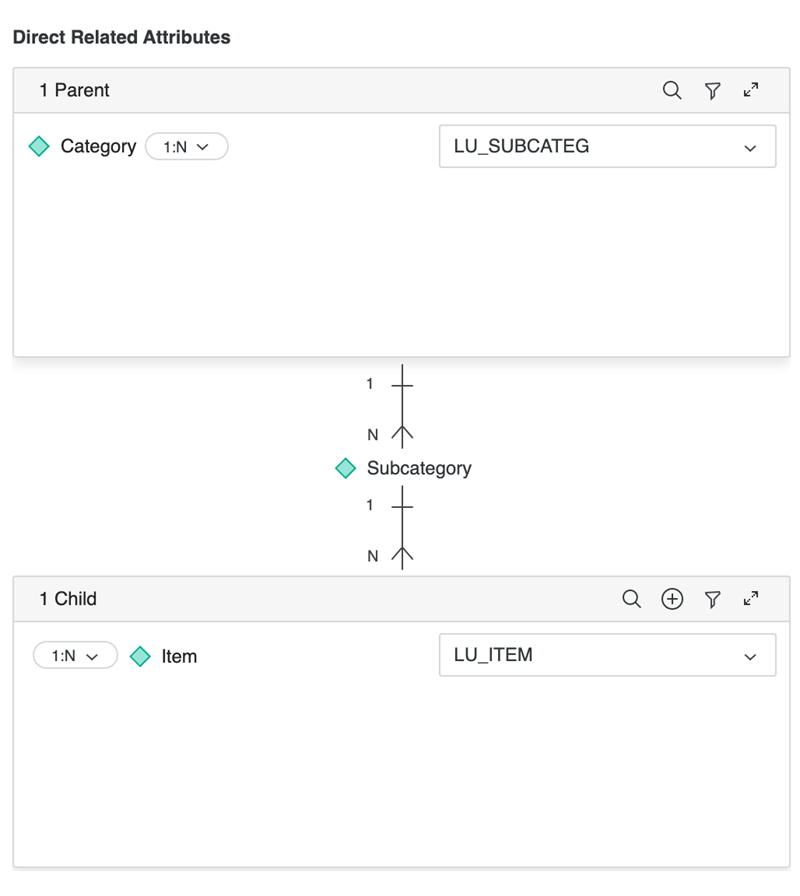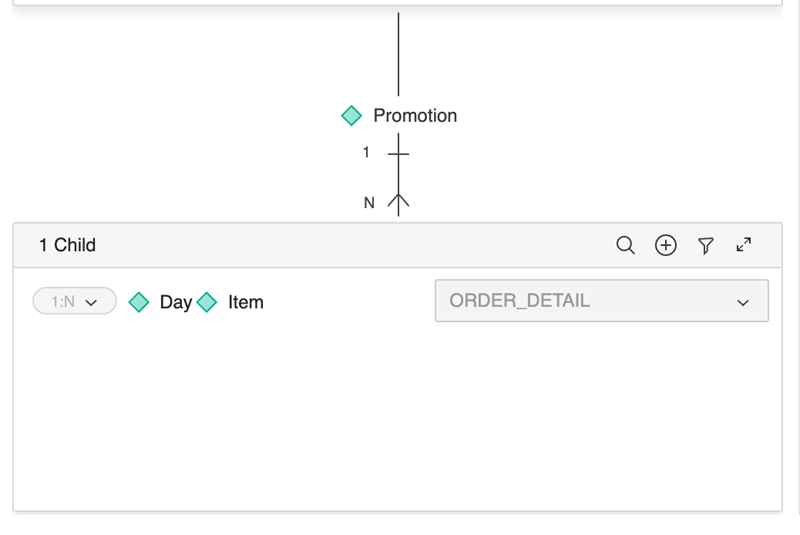Update an attribute's relationships
You can try out this workflow at REST API Playground.
Learn more about Strategy REST API Playground here.
This workflow sample demonstrates how to update an attribute's relationship through the Modeling service.
- Create a changeset.
- Update the attribute's relationship.
- Commit the changeset.
- Delete the changeset.
You want to update the relationship for the “Subcategory“ attribute object with ID E8C034036E4EE6404513A6B12FAE9481 in the MicroStrategy Tutorial project. The project ID is B7CA92F04B9FAE8D941C3E9B7E0CD754.
Get the authorization token needed to execute the request with POST /api/auth/login.
Get the project ID from GET /api/projects.
Changesets are used in this workflow. For information on how to create and use changesets, see Changesets.
Update the attribute's relationship
Use PUT /api/model/systemHierarchy/attributes/{attributeId}/relationships.
You want to update the relationship of the "Subcategory" attribute object by adding relationships between "Category" and "Subcategory", and "Subcategory" and "Item". The object ID of the "Subcategory" attribute is E8C034036E4EE6404513A6B12FAE9481 in the MicroStrategy Tutorial project. The project ID is B7CA92F04B9FAE8D941C3E9B7E0CD754.
The following screenshot shows how these relationships are shown in the editor.

Sample Request Header:
"accept": "application/json"
"X-MSTR-AuthToken": "o0ak9privdo27nfo798j40m8aa"
"X-MSTR-MS-Changeset": "F768352DC66E40F2BCD9A3F050ECDE9B"
Sample Request Body:
{
"relationships": [
{
"parent": {
"objectId": "E8C034036E4EE6404513A6B12FAE9481",
"subType": "attribute",
"name": "Subcategory"
},
"child": {
"objectId": "8D679D4211D3E4981000E787EC6DE8A4",
"subType": "attribute",
"name": "Item"
},
"relationshipTable": {
"objectId": "8D67937411D3E4981000E787EC6DE8A4",
"subType": "logical_table",
"name": "LU_ITEM"
},
"relationshipType": "one_to_many"
},
{
"parent": {
"objectId": "8D679D3711D3E4981000E787EC6DE8A4",
"subType": "attribute",
"name": "Category"
},
"child": {
"objectId": "E8C034036E4EE6404513A6B12FAE9481",
"subType": "attribute",
"name": "Subcategory"
},
"relationshipTable": {
"objectId": "8D6793B611D3E4981000E787EC6DE8A4",
"subType": "logical_table",
"name": "LU_SUBCATEG"
},
"relationshipType": "one_to_many"
}
]
}
Sample Curl:
curl -X PUT "https://demo.microstrategy.com/MicroStrategyLibrary/api/model/systemHierarchy/attributes/E8C034036E4EE6404513A6B12FAE9481/relationships" -H "accept: application/json" -H "X-MSTR-AuthToken: o0ak9privdo27nfo798j40m8aa" -H "X-MSTR-MS-Changeset: F768352DC66E40F2BCD9A3F050ECDE9B" -H "Content-Type: application/json" -d "{\\"relationships\\":[{\\"parent\\":{\\"objectId\\":\\"E8C034036E4EE6404513A6B12FAE9481\\",\\"subType\\":\\"attribute\\",\\"name\\":\\"Subcategory\\"},\\"child\\":{\\"objectId\\":\\"8D679D4211D3E4981000E787EC6DE8A4\\",\\"subType\\":\\"attribute\\",\\"name\\":\\"Item\\"},\\"relationshipTable\\":{\\"objectId\\":\\"8D67937411D3E4981000E787EC6DE8A4\\",\\"subType\\":\\"logical_table\\",\\"name\\":\\"LU_ITEM\\"},\\"relationshipType\\":\\"one_to_many\\"},{\\"parent\\":{\\"objectId\\":\\"8D679D3711D3E4981000E787EC6DE8A4\\",\\"subType\\":\\"attribute\\",\\"name\\":\\"Category\\"},\\"child\\":{\\"objectId\\":\\"E8C034036E4EE6404513A6B12FAE9481\\",\\"subType\\":\\"attribute\\",\\"name\\":\\"Subcategory\\"},\\"relationshipTable\\":{\\"objectId\\":\\"8D6793B611D3E4981000E787EC6DE8A4\\",\\"subType\\":\\"logical_table\\",\\"name\\":\\"LU_SUBCATEG\\"},\\"relationshipType\\":\\"one_to_many\\"}]}"
Sample Response Body:
You can view the new attribute relationships in the body of the response.
{
"relationships": [
{
"parent": {
"objectId": "E8C034036E4EE6404513A6B12FAE9481",
"subType": "attribute",
"name": "Subcategory"
},
"child": {
"objectId": "8D679D4211D3E4981000E787EC6DE8A4",
"subType": "attribute",
"name": "Item"
},
"relationshipTable": {
"objectId": "8D67937411D3E4981000E787EC6DE8A4",
"subType": "logical_table",
"name": "LU_ITEM"
},
"relationshipType": "one_to_many"
},
{
"parent": {
"objectId": "8D679D3711D3E4981000E787EC6DE8A4",
"subType": "attribute",
"name": "Category"
},
"child": {
"objectId": "E8C034036E4EE6404513A6B12FAE9481",
"subType": "attribute",
"name": "Subcategory"
},
"relationshipTable": {
"objectId": "8D6793B611D3E4981000E787EC6DE8A4",
"subType": "logical_table",
"name": "LU_SUBCATEG"
},
"relationshipType": "one_to_many"
}
]
}
Response Code: 200 (The attribute's relationships are updated successfully in the changeset.)
Example
You want to update the relationship for the "Promotion" attribute object with ID "6E6E867115400A10F71D979E00325F4A" by adding a joint relationship with "Day" and "Item" as the join-child of "Promotion".
The following screenshot shows how this relationship is shown in the editor.

Sample Request Body:
{
"relationships": [
{
"parent": {
"objectId": "6E6E867115400A10F71D979E00325F4A",
"subType": "attribute",
"name": "Promotion"
},
"jointChild": [
{
"objectId": "96ED3EC811D5B117C000E78A4CC5F24F",
"subType": "attribute",
"name": "Day"
},
{
"objectId": "8D679D4211D3E4981000E787EC6DE8A4",
"subType": "attribute",
"name": "Item"
}
],
"relationshipTable": {
"objectId": "8D6793CE11D3E4981000E787EC6DE8A4",
"subType": "logical_table",
"name": "ORDER_DETAIL"
},
"relationshipType": "one_to_many"
}
]
}